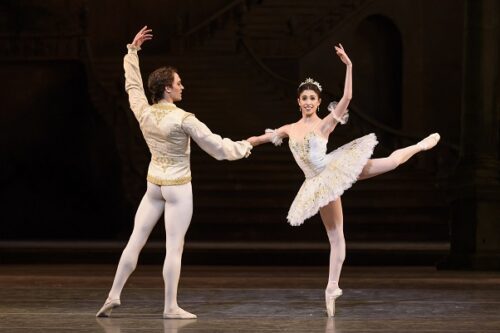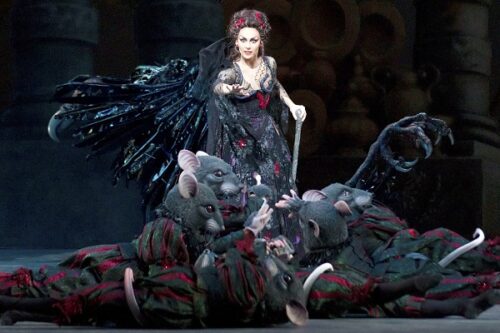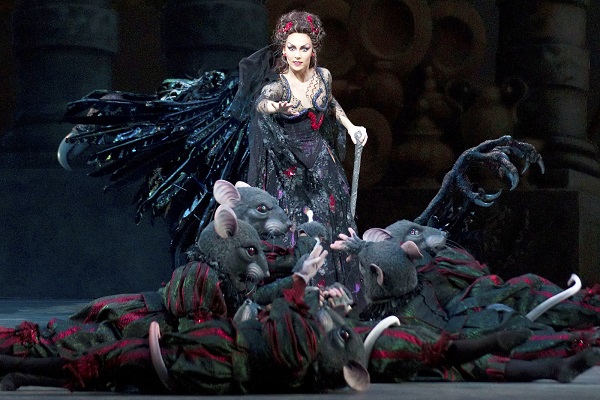 United Kingdom Tchaikovsky, The Sleeping Beauty: Dancers of The Royal Ballet, Students of The Royal Ballet School, Orchestra of the Royal Opera House Orchestra / Jonathan Lo (conductor). Broadcast live (directed by Ross MacGibbon) from the Royal Opera House, Covent Garden, (introduced by Dame Darcey Bussell and Petroc Trelawny) to Cineworld Basildon, Essex. 25.5.2023. (JPr)
United Kingdom Tchaikovsky, The Sleeping Beauty: Dancers of The Royal Ballet, Students of The Royal Ballet School, Orchestra of the Royal Opera House Orchestra / Jonathan Lo (conductor). Broadcast live (directed by Ross MacGibbon) from the Royal Opera House, Covent Garden, (introduced by Dame Darcey Bussell and Petroc Trelawny) to Cineworld Basildon, Essex. 25.5.2023. (JPr)

I have seen, heard, and reported on The Royal Ballet’s current The Sleeping Beauty production before so some repetition is inevitable. The broadcast itself also repeated a film I first saw in 2017 that was particularly interesting when considering the 2006 staging by The Royal Ballet’s former director, Dame Monica Mason. Francesca Franchi (now in 2023 the former) Head of ROH Collections, talked about how what we see ‘is a recreation of the production that reopened the opera house after the end of the Second World War … The aim of this is to recreate that atmosphere of that production of 1946.’ Monica Mason herself added that it had been ‘closed as a theatre and became a dance hall [and was leased by Mecca Cafés Ltd and used by the troops on leave] … After the war the [Sadler’s Wells] company was invited to be resident here in the Royal Opera House and that is what came to the 1946 reopening and the first performance of The Sleeping Beauty.’ Ms Franchi added how this had been deemed very appropriate as the ballet involves ‘reawakening of the Princess after her 100-year sleep and it was the reawakening of the opera house.’ Ms Mason added that ‘After the gloom and the devastation of the war years, suddenly the curtains opened on something that was so grand and a fairy tale. The audience was just captivated by the magnificence of it.’ And so we still were in 2023, both in the Cineworld Basildon and, no doubt, those who were watching the 950th performance of The Sleeping Beauty by The Royal Ballet in, coincidentally, 950 cinemas throughout the world.
Oliver Messel’s production became the stuff of legend and I heard about it in glowing terms from my mother who was there on the second night in 1946. Interviewed again backstage in 2023, Monica Mason repeated how her intention was to recreate that semi-mythical production as closely as possible to Messel’s original because ‘knowing that our [The Royal Ballet’s] 60th birthday was coming up in 2006 I thought it would be really appropriate to go back to 1946, the year Ninette de Valois produced a production of The Sleeping Beauty that lasted for years and years … The designs are so fabulous even now today. For this production we of course visited the V&A theatre museum and checked on all the old designs. Not all of them were there … but [the late] Peter Farmer filled in the gaps for us brilliantly.’ (I must still remind readers that no production for me has ever surpassed that by Rudolf Nureyev for London Festival Ballet in 1975 which I doubt English National Ballet will ever revive.)
The basis of this The Sleeping Beauty are Marius Petipa’s steps which were given to the company by Nicholas Sergeyev, régisseur of Russia’s Imperial Mariinsky Theatre. These have accreted some additional choreography over the years including Frederick Ashton’s Act II variations for Aurora and the Prince, Anthony Dowell’s interpretation of Carabosse and her rats, as well as a new – rather prosaic – Act I Garland Dance from Christopher Wheeldon.
Director of The Royal Ballet, Kevin O’Hare, remarked: ‘This is really our signature ballet … it is beautifully classical and shows off the company well … there’s all the fairy solos, there’s also things like she [Mason] did invite Christopher Wheeldon to create a new [Garland] waltz … in Act I so that’s really challenging for the younger dancers in the company and even doing things like the Polonaise and Mazurka and getting the style of that is really important and it really puts you on the steps of being part of the classical ballet company.’
The costumes are muted pastel shades for the Prince, Princess, fairies, and most of those actually dancing, but were vividly coloured and elaborate for the various courtiers – notably Master of Ceremonies, Cattalabutte – who do little more than just stand around. The backdrops have a Caspar David Friedrich quality to them and generally the sets are quaintly two-dimensional and redolent of a toy theatre in their chocolate-boxy – and very appealing – baroque prettiness. They continue to provide a handsome background to the dancing and do not overpower it in any way. The students of The Royal Ballet School (one smiley one especially) and the entire corps de ballet seemed totally engaged with what was going on and never ‘switched off’. This was very important considering Ross MacGibbon’s direction for the cinema which seemed an ideal mix of visually attractive scene-setting long shots and captivating close-ups. The latter gives no room to hide when it comes to the synchronicity of movement during the ensemble moments (impeccable on this occasion), but it can also unfortunately highlight any momentary insecurities in individual moments (such as during Yasmine Naghdi’s Rose Adage).
I have written before about how I admire the clarity of the mime we see from the dancers of the company and another important attempt was made to explain – in some rehearsal footage of Kristen McNally (Carabosse) and Mayara Magri (Lilac Fairy) – what the hand gestures are telling us. This will have been very useful for the ballet novices watching.

It was good to see everyone on top form and dancing with such great energy. In a ballet with so many soloist roles it is impossible to mention everybody. Bennet Gartside caught the eye as Cattalabutte, the prissy, over-officious master of ceremonies. By leaving the fairy Carabosse off the guest list for Princess Aurora’s christening it spelled (!) disaster for her parents. Elizabeth McGorian was once again a regal, caring, and compassionate Queen and mother to Aurora, our heroine, whose pricked finger results in the court sleeping for 100 years. I have seen Kristen McNally before as Carabosse and – despite looking oddly attractive (at least to me) – she is evil-incarnate, ‘chews the scenery’ whenever she is onstage, and it is impossible to take your eyes off her. Something I had not noticed before is how important the role of the English Prince is while Aurora is balancing and pirouetting in Act I. The vastly experienced Gary Avis (who was also involved in restaging the ballet) was a great help in getting Naghdi’s Aurora through some difficult moments.
As the Lilac Fairy, whose consolation lifts Carabosse’s curse, Mayara Magri danced prettily and radiated beneficence and more importantly acted the role so wonderfully as to make me truly believe she was the power of good that could vanquish the wicked fairy. Isabella Gasparini was suitably ‘enchanting’ as the Prologue’s Fairy of the Enchanted Garden and as Princess Florine in a show-stopping pas de deux with Joseph Sissens, who though fluttering like Gasparini was a soaring Bluebird.
In the Rose Adage Aurora dances with four princes to decide which she might want to marry and each one hands her a rose. Oddly Darcey Bussell seemed to make light of the challenges of Aurora’s Act I entrance but it looks fearsomely difficult to me. The ballerina must steady herself for eight poised and wobble-free balances whilst totally exposed centre stage and, as here, with the camera focused right on her. In the circumstances Yasmine Naghdi – who possess a wonderful technique and great musicality – did creditably well but I suspect she has danced the Rose Adage better on other occasions. The good news is that she smiled through it regardless. Elsewhere, Naghdi was an enigmatic, otherworldly presence during the pas de deux in the Act II Vision Scene and by trusting the secure partnering of Matthew Ball launched herself with élan into the famous trio of fish dives in the final act. In truth, the wedding grand pas de deux was an absolute masterclass from both of them and a fitting end to a memorable performance.
The revelation of this performance was Matthew Ball’s Prince Florimund. Through some consummate acting he brought the prince to life which is unusual to see in this ballet. His melancholic Act II solo perfectly suggested the prince’s loneliness and longing for true affection. Ball then leapt and bound around with great flair, elegance, strength, virtuosity, and moreover, genuine presence. Currently Liverpool-born Ball seems more of a Russian dancer than The Royal Ballet’s Vadim Muntagirov who was born there in Chelyabinsk. I suspect one of Ball’s ballet heroes is Rudolf Nureyev. Naghdi and Ball brought true drama to the proceedings because of the great chemistry between them and – along with the excellence of McNally and Magri – elevated this performance of The Sleeping Beauty far beyond dancers just replicating the steps they have done so many times before.
Finally, kudos to Jonathan Lo who led the splendid orchestra through a brisk, nuanced and exquisitely played account of Tchaikovsky’s rich and varied score. Lo never sounded as if he ever held back at the big moments or – while always sensitive to their needs – suggested he indulged his dancers.
Jim Pritchard
Production:
Choreography – Marius Petipa
Additional choreography – Frederick Ashton, Anthony Dowell, and Christopher Wheeldon
Production – Monica Mason and Christopher Newton (after Ninette de Valois and Nicholas Sergeyev)
Scenario – Ivan Vsevolozhsky
Original designs – Oliver Messel
Additional designs – Peter Farmer
Lighting designer – Mark Jonathan
Staging – Christopher Carr and Gary Avis
Cast included:
Princess Aurora – Yasmine Naghdi
Prince Florimund – Matthew Ball
Carabosse – Kristen McNally
Lilac Fairy – Mayara Magri
Princess Florine – Isabella Gasparini
The Bluebird – Joseph Sissens
Cattalabutte – Bennet Gartside
